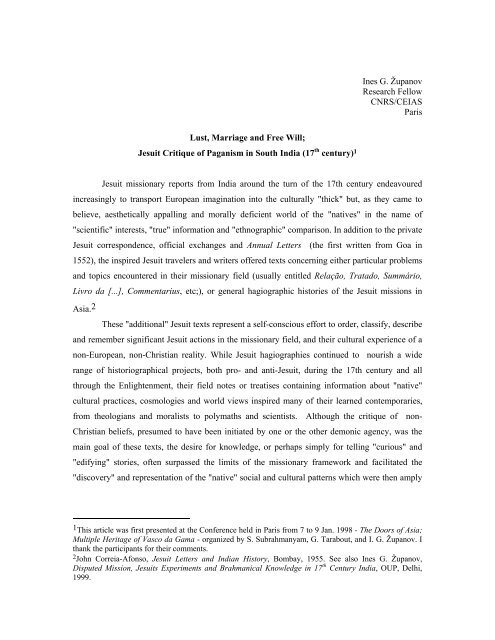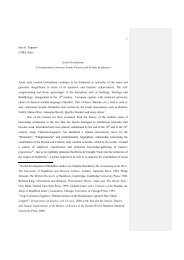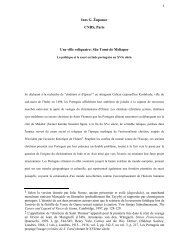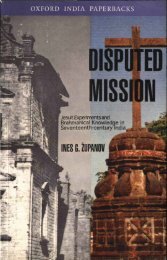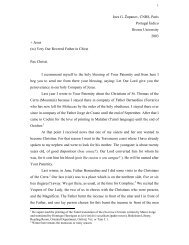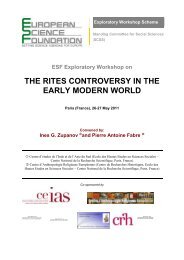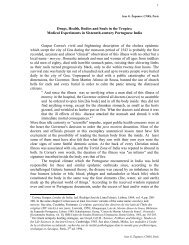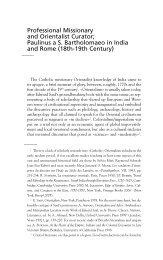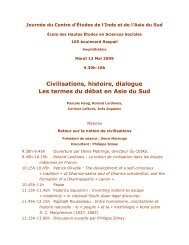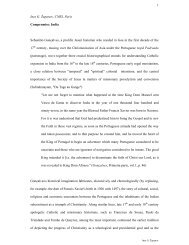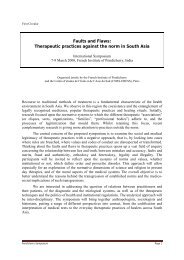Lust, Marriage and Free Will; Jesuit Critique of - Ines G. Županov
Lust, Marriage and Free Will; Jesuit Critique of - Ines G. Županov
Lust, Marriage and Free Will; Jesuit Critique of - Ines G. Županov
Create successful ePaper yourself
Turn your PDF publications into a flip-book with our unique Google optimized e-Paper software.
Asia. 2 These "additional" <strong>Jesuit</strong> texts represent a self-conscious effort to order, classify, describe<br />
<strong>Ines</strong> G. <strong>Županov</strong><br />
Research Fellow<br />
CNRS/CEIAS<br />
Paris<br />
<strong>Lust</strong>, <strong>Marriage</strong> <strong>and</strong> <strong>Free</strong> <strong>Will</strong>;<br />
<strong>Jesuit</strong> <strong>Critique</strong> <strong>of</strong> Paganism in South India (17 th century) 1<br />
<strong>Jesuit</strong> missionary reports from India around the turn <strong>of</strong> the 17th century endeavoured<br />
increasingly to transport European imagination into the culturally "thick" but, as they came to<br />
believe, aesthetically appalling <strong>and</strong> morally deficient world <strong>of</strong> the "natives" in the name <strong>of</strong><br />
"scientific" interests, "true" information <strong>and</strong> "ethnographic" comparison. In addition to the private<br />
<strong>Jesuit</strong> correspondence, <strong>of</strong>ficial exchanges <strong>and</strong> Annual Letters (the first written from Goa in<br />
1552), the inspired <strong>Jesuit</strong> travelers <strong>and</strong> writers <strong>of</strong>fered texts concerning either particular problems<br />
<strong>and</strong> topics encountered in their missionary field (usually entitled Relação, Tratado, Summário,<br />
Livro da [...], Commentarius, etc;), or general hagiographic histories <strong>of</strong> the <strong>Jesuit</strong> missions in<br />
<strong>and</strong> remember significant <strong>Jesuit</strong> actions in the missionary field, <strong>and</strong> their cultural experience <strong>of</strong> a<br />
non-European, non-Christian reality. While <strong>Jesuit</strong> hagiographies continued to nourish a wide<br />
range <strong>of</strong> historiographical projects, both pro- <strong>and</strong> anti-<strong>Jesuit</strong>, during the 17th century <strong>and</strong> all<br />
through the Enlightenment, their field notes or treatises containing information about "native"<br />
cultural practices, cosmologies <strong>and</strong> world views inspired many <strong>of</strong> their learned contemporaries,<br />
from theologians <strong>and</strong> moralists to polymaths <strong>and</strong> scientists. Although the critique <strong>of</strong> non-<br />
Christian beliefs, presumed to have been initiated by one or the other demonic agency, was the<br />
main goal <strong>of</strong> these texts, the desire for knowledge, or perhaps simply for telling "curious" <strong>and</strong><br />
"edifying" stories, <strong>of</strong>ten surpassed the limits <strong>of</strong> the missionary framework <strong>and</strong> facilitated the<br />
"discovery" <strong>and</strong> representation <strong>of</strong> the "native" social <strong>and</strong> cultural patterns which were then amply<br />
1 This article was first presented at the Conference held in Paris from 7 to 9 Jan. 1998 - The Doors <strong>of</strong> Asia;<br />
Multiple Heritage <strong>of</strong> Vasco da Gama - organized by S. Subrahmanyam, G. Tarabout, <strong>and</strong> I. G. <strong>Županov</strong>. I<br />
thank the participants for their comments.<br />
2 John Correia-Afonso, <strong>Jesuit</strong> Letters <strong>and</strong> Indian History, Bombay, 1955. See also <strong>Ines</strong> G. <strong>Županov</strong>,<br />
Disputed Mission, <strong>Jesuit</strong>s Experiments <strong>and</strong> Brahmanical Knowledge in 17 th Century India, OUP, Delhi,<br />
1999.
used <strong>and</strong> <strong>of</strong>ten reordered by the European-based compilers <strong>and</strong> writers. 3 The fact that <strong>Jesuit</strong><br />
missionaries <strong>of</strong>ten produced written materials without specifically acknowledging individual<br />
authorship made way for the notorious traffic <strong>and</strong> falsification <strong>of</strong> their "ethnographic" texts well<br />
into the 19th century. 4<br />
The devil <strong>of</strong> contention appeared, however, more than ever in the realm <strong>of</strong> what was<br />
perceived <strong>and</strong> conceptualized by the missionaries as social rather than religious phenomena.<br />
<strong>Jesuit</strong> interest in <strong>and</strong> penetration <strong>of</strong> the "pagan" or "infidel" social field was not accidental but<br />
was enshrined at the very core <strong>of</strong> the <strong>Jesuit</strong> being <strong>and</strong> acting in the world. 5 More <strong>of</strong>ten than not<br />
social <strong>and</strong> psychological engineering, for example, through education, preceded "correct"<br />
religious or theological grafting. As in the course <strong>of</strong> the 17th <strong>and</strong> the 18 th centuries in Europe, the<br />
fissure between the social <strong>and</strong> the religious continued to grow, the former encompassing the<br />
political <strong>and</strong> the public, the latter anchoring the spiritual <strong>and</strong> the private, as <strong>Jesuit</strong> methods<br />
(educational <strong>and</strong> confessional) initially conceived to deal with both approached their apogee <strong>and</strong><br />
declined. During the transitional phase in which religious concerns <strong>and</strong> frames <strong>of</strong> reference were<br />
gradually eclipsed by the social, especially by the end <strong>of</strong> the 16th <strong>and</strong> the early decades <strong>of</strong> the<br />
17th century, the <strong>Jesuit</strong> missionaries in Asia became increasingly interested in the problem <strong>of</strong><br />
"indigenous" ethics, based on what they saw as specific psychological <strong>and</strong> physiological<br />
dispositions such as enhanced sensuality <strong>and</strong> oversexed bodily functions. 6 The origins <strong>of</strong><br />
indigenous moral laws, resembling or dissembling "natural" laws, <strong>and</strong> their application within the<br />
indigenous social structure, were debated time <strong>and</strong> again, both within India <strong>and</strong> without. 7<br />
By looking into two treatises, one written by a Portuguese <strong>Jesuit</strong>, Diogo Gonçalves <strong>and</strong><br />
the other by an Italian, Jacomo Fenicio, who both worked as missionaries at nearly the same time<br />
<strong>and</strong> who both traveled extensively through the same Malabar region in southwest India, my aim is<br />
to juxtapose <strong>and</strong> comment on two related historical/historiographical issues. Inspired by de<br />
3 Among the growing literature on <strong>Jesuit</strong> scientific missions <strong>and</strong> achievements, see Luce Giard, (ed.) Les<br />
jésuites à la Renaissance; Système éducatif et production du savoir, Paris, 1995 <strong>and</strong> John O'Malley, Gauvin<br />
A. Bailey, Steven J. Harris, T. Frank Kennedy (eds.), The <strong>Jesuit</strong>s. Cultures, Sciences <strong>and</strong> the Arts, 1540-<br />
1773, Toronto, 1999.<br />
4 Sylvia Murr, L'Inde philosophique entre Bossuet et Voltaire, l'indologie du Père Coeurdoux; stratégies,<br />
apologétique et scientificité, 2 vols., Paris, 1987.<br />
5 On the first seven founding fathers <strong>of</strong> the Society <strong>of</strong> Jesus <strong>and</strong> their conception <strong>of</strong> " mobile" apostolate,<br />
see John W. O'Malley, The First <strong>Jesuit</strong>s, Harvard, 1993.<br />
6 On the displacement <strong>of</strong> the frames <strong>of</strong> reference from religion to ethics see Michel de Certeau's still<br />
unsurpassed statement in the chapter 'The Formality <strong>of</strong> Practices, From Religious Systems to the Ethics <strong>of</strong><br />
Enlightenment (the Seventeenth <strong>and</strong> Eighteenth Centuries)', The Writing <strong>of</strong> History (Paris, 1975), New<br />
York, pp. 1988-205.<br />
7 For controversies raging over Latin American "Indians" see Anthony Pagden, The fall <strong>of</strong> natural man;<br />
The American Indian <strong>and</strong> the origins <strong>of</strong> comparative ethnology, Cambridge, 1982.
Certeau's laconic (<strong>and</strong> by now famous) lead, "because it is in fact the text's reworking <strong>of</strong> space<br />
that simultaneously produces the space <strong>of</strong> the text", the first issue concerns the narrative fabric <strong>of</strong><br />
the texts, the analysis <strong>of</strong> which should help us discern <strong>and</strong> underst<strong>and</strong> the capacity <strong>of</strong> these texts<br />
to construct ethnographic evidence. 8 The second should take us beyond the field <strong>of</strong> rhetoric<br />
through the thick <strong>and</strong> thin <strong>of</strong> <strong>Jesuit</strong> social engineering in the post-Tridentine period.<br />
In a word, since the devil is also in écriture, my intention is to reveal the nexus between<br />
writing <strong>and</strong> action which produced a set <strong>of</strong> cultural patterns, <strong>and</strong> suspended in it what we have<br />
came to call "Hinduism". More specifically, I will be looking at how the <strong>Jesuit</strong> missionaries,<br />
called upon to implement the canons <strong>of</strong> the council <strong>of</strong> Trent which re-emphasized the sacramental<br />
nature <strong>of</strong> matrimonium, came to conceptualize the marriage <strong>and</strong> kinship institutions they<br />
encountered in the Malabar region as "illegal" <strong>and</strong> false. At the same time, in other missionary<br />
locations in India, such as the Fishery Coast in the Gulf <strong>of</strong> Manār, Christian communities <strong>of</strong><br />
converts were also under pressure to emend their marriage customs <strong>and</strong> rites in order to comply<br />
with the directions from Rome, in spite <strong>of</strong> special dispensations accorded to them by the popes<br />
prior to the Council <strong>of</strong> Trent.<br />
A close family <strong>and</strong> caste solidarity among "gentiles" <strong>and</strong> Christians alike appeared to the<br />
<strong>Jesuit</strong>s as signs <strong>of</strong> the lack <strong>of</strong> free will (liberum arbitirum), itself a mixed concept containing<br />
theological shades <strong>of</strong> a "misanthropic" sense elaborated by St. Augustine <strong>and</strong> Luther through<br />
Erasmian human volition as dependent on, but separate from, the divine until an ever more<br />
pr<strong>of</strong>ane meaning <strong>of</strong> individual consciousness. 9 In spite <strong>of</strong> a typically <strong>Jesuit</strong> cultivation <strong>of</strong> infinite<br />
interiority <strong>and</strong> conscious choice ("election"), refusal <strong>of</strong> or indifference to the Christian message<br />
<strong>and</strong> to conversion was immediately br<strong>and</strong>ed as pro<strong>of</strong> <strong>of</strong> a fatal deficiency in both free will <strong>and</strong> its<br />
ultimate support, divine grace. For at least a century <strong>and</strong> a half, the <strong>Jesuit</strong>s would propose various<br />
"origin" stories in order to explain that deficiency among the non-Christians. What those stories<br />
have in common, even when referring to different societies <strong>and</strong> cultures <strong>of</strong> Asia, is the fact that<br />
complex cultural <strong>and</strong> psychological formations were reduced in missionary texts to simplified<br />
<strong>and</strong> readily identifiable functions, as if they were a part <strong>of</strong> the same, in <strong>Jesuit</strong> words, mindless <strong>and</strong><br />
diabolic machine (máquina) <strong>of</strong> paganism, which indefinitely barred these societies from<br />
practicing <strong>and</strong> developing the "true morality" <strong>and</strong> "ethics". 10 The same questions embedded<br />
8 Michel de Certeau, Heterologies; discourse on the Other, (transl.) Minneapolis, 1986, p. 68.<br />
9 "Le libre arbitre" (integral translation into French <strong>of</strong> the Diatribè sive Collatio de libero arbitrio), Erasme,<br />
eds. Calude Blum André Godin, Jean-Claude Margolin <strong>and</strong> Daniel Ménager, Paris, 1992, p. 763.<br />
10 Devoid <strong>of</strong> morality, non-Christians were likened to a variety <strong>of</strong> inferior creatures from childlike<br />
imbeciles to brutish beasts. It is important to note that this newly "freed" human subjectivity was in fact<br />
increasingly seen as entrapped <strong>and</strong> enchained within a new golden cage <strong>of</strong> societal norms, rules <strong>and</strong>
within this mechanistic matrix, though under different guises, were taken up after <strong>Jesuit</strong><br />
missionaries by British colonial (<strong>and</strong> various post-colonial) ethnographers. The denial <strong>of</strong> the<br />
existence <strong>of</strong> individual <strong>and</strong> social agency in Hinduism <strong>and</strong> its social <strong>and</strong> political ramifications,<br />
recently denounced by both social scientists <strong>and</strong> historians, has a long, mixed <strong>and</strong> multiple<br />
ancestry. 11 Some <strong>of</strong> its genealogical <strong>and</strong> geological str<strong>and</strong>s <strong>and</strong> layers are clearly visible in early<br />
Catholic missionary texts.<br />
Two <strong>Jesuit</strong> writers on the Malabar coast in the early 17th century<br />
When Jacobus Fenicius, a twenty six year old Capuan, appeared in the <strong>Jesuit</strong> catalogue<br />
<strong>of</strong> the Provinciae Indiae Orientalis in 1584, he was described as learned in philosophy <strong>and</strong><br />
theology, <strong>of</strong> good judgement <strong>and</strong> intellectual disposition (ingenium), <strong>and</strong> as holding the rank <strong>of</strong><br />
confessor. In addition, according to Aless<strong>and</strong>ro Valignano's confidential information, Fenicio was<br />
also "beginning to acquire experience in his <strong>of</strong>fice <strong>of</strong> converting infidels" 12 . The same year in a<br />
letter written in Cochin <strong>and</strong> destined for the Provincial <strong>of</strong> the <strong>Jesuit</strong> province in Naples, Ludovico<br />
Maselli, Jacomo Fenicio expressed his "great compassion" (gran compassione) for the gentiles<br />
who were living in the "misery <strong>and</strong> darkness" <strong>of</strong> superstition <strong>and</strong> "continuously perform<br />
ceremonies, feasts <strong>and</strong> dances" for their idols. 13 Some twenty years later, his missionary<br />
experience on the Malabar coast in Cochin, Purakkāî [Porca in Port.], Calicut, Tanur <strong>and</strong> many<br />
other smaller missions, enabled him to write a compendium <strong>of</strong> information concerning, as he<br />
called it, "the first Book <strong>of</strong> the Sect <strong>of</strong> the Oriental Indians, principally the Malabars". Failure or<br />
customs. See for example, John Martin, "Inventing Sincerity, Refashioning Prudence: The Discovery <strong>of</strong> the<br />
Individual in Renaissance Europe", The American Historical Review, vol. 102, No. 5, Dec. 1997, pp. 1309-<br />
1342. For a seminal work on the difficulties <strong>and</strong> solutions concerning the conceptualization <strong>of</strong> the status <strong>of</strong><br />
American Indian in the 16 th century see Anthony Pagden, The fall <strong>of</strong> natural man; The American Indian<br />
<strong>and</strong> the origins <strong>of</strong> comparative ethnology, Cambridge, (1982) 1990.<br />
11 The rehabilitation <strong>of</strong> the subaltern (gendered, tribal, local, indigenous, etc.) agency silenced by colonial<br />
historiography was at the heart <strong>of</strong> the project pr<strong>of</strong>essed by the Subaltern Studies group <strong>of</strong> scholars <strong>and</strong><br />
writers. For the recent critical discussion on epistemic results <strong>and</strong> inherent problems in this most prominent<br />
fin de siècle historiographical school in India, see Sumit Sarkar's recent articles, "Post-modernism <strong>and</strong> the<br />
writing <strong>of</strong> history", Studies in History, July-Dec., 1999, Vol. XV, No.2, pp. 293-322 <strong>and</strong> the chapter ,"The<br />
Decline <strong>of</strong> the Subaltern in Subaltern Studies", in his Writing Social History, OUP, Delhi, 1998, pp. 82-<br />
108.<br />
12 Ioseph Wicki, S.J., Documenta Indica [henceforth DI], Rome, 1975, vol. XIII, p. 638. (Fenicio was born<br />
in 1558, entered the Society <strong>of</strong> Jesus in 1580 <strong>and</strong> went to India in 1583. He died in Cochin in 1632.)<br />
Separate from the <strong>of</strong>ficial provincial catalogue providing information on <strong>Jesuit</strong> personnel, another<br />
confidential catalogue was attached by the Provincial, Aless<strong>and</strong>ro Valignano. These "secret" evaluations<br />
were a common <strong>and</strong> accepted practice among the <strong>Jesuit</strong>s.<br />
13 Of all the versions <strong>of</strong> his name - Giacomo, Jacopo, Jacome, Jácome; Fenicio, Fenizio, Phinicio, quite<br />
arbitrarily I havedecided to use henceforth Jacomo Fenicio. DI, XIII, p. 739.
efusal to clearly assert authorship <strong>of</strong> this text - <strong>of</strong> which the integral manuscript is available in<br />
the Manuscript Room <strong>of</strong> the British Library in London [Sloane 1820] - perhaps indicates that he<br />
considered it primarily as a missionary tool for collective use, <strong>and</strong> as a way <strong>of</strong> introducing <strong>Jesuit</strong><br />
missionary novices to local non-Christian cosmogony, theology <strong>and</strong> tradition <strong>and</strong>, ultimately, as a<br />
means <strong>of</strong> facilitating the composition <strong>of</strong> sermons specifically directed at refuting what were<br />
perceived as false, non-Christian doctrines. The fact that his text or major parts <strong>of</strong> it, without<br />
acknowledgement <strong>of</strong> Fenicio's authorship, acquired fame during the 17 th <strong>and</strong> 18 th centuries in<br />
works <strong>of</strong> such compilators as Philippus Baldaeus <strong>and</strong> Manuel de Faria y Sousa was unrelated to<br />
his intentions. 14<br />
Similarly, Diogo Gonçalves, a Portuguese <strong>Jesuit</strong> working at the same time in the same<br />
region, completed around 1615 his História do Malabar, which he left unsigned. 15 Compared to<br />
Fenicio, Gonçalves is less interested in theological speculation, but shares his passion for the<br />
quest <strong>of</strong> "origins", the origins <strong>of</strong> political hierarchy <strong>and</strong> social structure in particular. Unlike<br />
Fenicio who records "pagan" phenomena <strong>and</strong> cultural patterns in order to prepare a <strong>Jesuit</strong><br />
doctrinal <strong>of</strong>fensive, Gonçalves writes both as a missionary <strong>and</strong> an <strong>of</strong>ficial Portuguese spy. He not<br />
only provided strategic information on, for example, the exact location <strong>of</strong> temples <strong>and</strong> the<br />
quantity <strong>of</strong> precious materials kept on the precincts, but also regarding the feasibility <strong>of</strong> an attack<br />
by Portuguese soldiers, to which he actively exhorted his compatriots. The temple <strong>of</strong> Chimindirão<br />
[Suchīndram] dedicated to Śiva <strong>and</strong> located between Kōttār <strong>and</strong> Kanniyākumāri is, according to<br />
Gonçalves, built "in the flatl<strong>and</strong>, a league away from the beach from where the Portuguese, if<br />
they so desire, can attack since it is the best place on the Cape (Comorin) to disembark" 16 .<br />
Another temple (pagode), between Kollam <strong>and</strong> Kayankulam in Trevilar (Trivilar), on a<br />
peninsular strip <strong>of</strong> l<strong>and</strong> belonging to the king <strong>of</strong> Travancore, preserved, according to the <strong>Jesuit</strong>,<br />
"some treasures, so close to the beach that we could reach them from the sea with our cannon<br />
14 For the history <strong>of</strong> the authorship attribution <strong>and</strong> the abridged published version <strong>of</strong> the text, see Jarl<br />
Charpentier, (ed. <strong>and</strong> intro.), The Livro da Seita dos Indios Orientais (Brit. Mus. Ms. Sloane 1820) <strong>of</strong><br />
Father Jacobo Fenicio, S.J", Uppsala, 1933 [henceforth Fenicio]. Manuel de Faria e Sousa, Asia<br />
Portuguesa, Lisbon, 1666-75 (EC.66.9, Archive Collection, SOAS, London). A. J. de Jong (ed.) Afgoderye<br />
der Oost-Indische heydenen door Philippus Baldaeus… The Hague, 1917. The fact that Fenicio wrote in<br />
Portuguese instead in his native Italian can be taken, perhaps, as an indication that his text was for the<br />
internal use <strong>of</strong> the missionaries in the Malabar regions, all <strong>of</strong> whom spoke Portuguese.<br />
15 A fairly legible <strong>and</strong> leather-bound manuscript is preserved in Archivum Romanum Societatis Iesu, Goa<br />
58. Published document is available in J. Wicki, P. Diogo Gonçalves S.I., História do Malavar, Rome,<br />
1953 [Henceforth, Gonçalves]. Diogo Goncalves was born in Vila Real in Portugal in 1561, joined the<br />
Society <strong>of</strong> Jesus in 1583, <strong>and</strong> arrived in Goa in 1591. He died in Kollam (Quilon) in 1640.<br />
16 Gonçalves, p. 83.
alls (pelouros)". 17 In addition, a big stone mosque not far from the temple could also be pounded<br />
from the sea. After these fantasies <strong>of</strong> pillaging <strong>and</strong> destruction, justified by religious<br />
righteousness, Gonçalves immediately continued with advantages <strong>of</strong> territorial conquest <strong>and</strong><br />
possession. "There should be more than two hundred palm trees besides many cultivated tracts<br />
(vargens); they give more than 20 thous<strong>and</strong> pardaos. Our armadas could enter through the reed<br />
bar (barra da Bica), pulling the galleys". The list <strong>of</strong> targets with all necessary geographical<br />
details <strong>and</strong> logistics unfolds through the succeeding pages, leading the prospective conquistador<br />
along the coast from Kollam to Cochin. 18 The kings <strong>and</strong> queens who happened to rule those<br />
coveted isl<strong>and</strong>s <strong>and</strong> peninsulas dotted with temples <strong>and</strong> mosques were in their turn portrayed as a<br />
bunch <strong>of</strong> bellicose little tyrants with dubious ancestors <strong>and</strong> legitimacy.<br />
Sex, <strong>Lust</strong>, <strong>and</strong> "Sociability" in the Tropics<br />
A few centuries before the appearance <strong>of</strong> ethnography, both Fenicio <strong>and</strong> Gonçalves<br />
underscored the importance <strong>of</strong> gathering evidence concerning the indigenous life-cycle<br />
ceremonies. Not only because the reproduction <strong>of</strong> the non-Christian society, both biological <strong>and</strong><br />
cultural, depended on them but also because the post-Tridentine papacy emphasized the<br />
sacramental nature <strong>of</strong> such ceremonies in Catholicism itself. The sacramental nature <strong>of</strong> marriage,<br />
as against Protestant opposition to such interpretation <strong>of</strong> the Scriptures, was reasserted throughout<br />
Catholic Europe during the second part <strong>of</strong> the 16th <strong>and</strong> early 17th centuries, <strong>and</strong> found its<br />
ramifications in the overseas missions in such questions as: Are there "true marriages" among the<br />
non-Christians? If there are, among which social groups? How does one define "true" or "false"<br />
marriage? What are the forces or actors within the non-Christian societies determining the nature<br />
<strong>of</strong> human relations such as kinship, which are closely related to the questions <strong>of</strong> marriage? And<br />
finally, how does one distinguish marriage ceremonies <strong>of</strong> the new Christian converts from the<br />
"pagan" ceremonies <strong>of</strong> the non-Christians?<br />
Both Fenicio <strong>and</strong> Gonçalves <strong>of</strong>fered descriptions <strong>and</strong> explanations by using cultural <strong>and</strong><br />
literary material accessible to them through their knowledge <strong>of</strong> Malayalam (<strong>and</strong> Tamil in<br />
Fenicio's case). Neither <strong>of</strong> them, however, had access to Sanskrit texts, except indirectly through<br />
Brahman informants. In spite <strong>of</strong> the richness <strong>of</strong> "facts" - keeping in mind a proviso that factum<br />
non est verum - which the two <strong>Jesuit</strong>s collected, their conceptual post-Tridentine Catholic grid<br />
channeled this "theater <strong>of</strong> paganism", as it later came to be known, into a display <strong>of</strong> various forms<br />
17 Gonçalves, p. 85.<br />
18 Gonçalves, pp. 85-88.
<strong>of</strong> "abusive", "irrational" behavior going against the marriage norms introduced in Europe in the<br />
second half <strong>of</strong> the 16 th century. 19<br />
For the two <strong>Jesuit</strong> writers, the sense <strong>of</strong> carnal lust, libido <strong>and</strong> concupiscence wafted, so to<br />
speak, through the Malabar air, captivating the minds <strong>and</strong> the souls <strong>of</strong> the "natives" (both<br />
Christian <strong>and</strong> non-Christian) <strong>and</strong> imprinted upon them the metaphors <strong>and</strong> allegories <strong>of</strong> sexual<br />
desire. 20 Fenicio's rendering <strong>of</strong> the "Brahmanical" conception <strong>of</strong> the creation <strong>of</strong> the universe, "so<br />
much devoid <strong>of</strong> reason" (tão fora de rezão), rapidly turns into an inventory <strong>of</strong> sexual symbols <strong>and</strong><br />
erotic scenes connected with the introduction into the text <strong>of</strong> the principal "Indian" deities;<br />
Bramâ, [Brahma], Visnu [Viòïu] <strong>and</strong> Ixora [Īśvara]. After an elaborate <strong>and</strong> confused story <strong>of</strong> the<br />
cosmic egg, the birth <strong>of</strong> the three gods is attributed to the appearance <strong>of</strong> a "triangular form called<br />
tricoma sacra in which grew another round thing called Guiuelinga [Śivalingam], signifying<br />
genital parts, the Guiuelinga <strong>of</strong> men <strong>and</strong> the triangle <strong>of</strong> women". 21 For a theologian such as<br />
Fenicio, creation <strong>and</strong> procreation could, on no account, be equated. Even less was he prepared to<br />
accept further information that the same "Śivalingam is the highest divinity Egasourunam<br />
[Ekasvarūpam]". 22<br />
After such dramatic staging <strong>of</strong> the creative power <strong>and</strong> action <strong>of</strong> the male sexual organ,<br />
Fenicio skillfully unseated all menace emanating from the object in question by turning it quickly<br />
into stone.<br />
"I was surprised", he wrote, "when I entered one day into a teuere, as they call the temple<br />
dedicated to gods; I saw in the chapel on the side where we place the altar on the floor the<br />
Śivalingam which was a round marble stone; as thick as a man's leg <strong>and</strong> in everything as equal<br />
<strong>and</strong> as long, more or less [the size <strong>of</strong>] an ell (covado) <strong>of</strong> a h<strong>and</strong> <strong>and</strong> placed on the right side on<br />
the ground <strong>and</strong> [vertically]st<strong>and</strong>ing (em pe)." 23<br />
Embodied in stone <strong>and</strong> enshrined in a fixed place, the Śivalingam was less threatening to the<br />
<strong>Jesuit</strong>s, in so far as it could be clearly identified as an "idol" <strong>and</strong> its "cosmic force" could be<br />
refuted by conventional arguments against idolatry, employed, practiced, tested <strong>and</strong> refined by<br />
19 Although the Council <strong>of</strong> Trent did provide a model against which to measure <strong>and</strong> judge all other forms,<br />
the situation was more complicated since even in Europe the assimilation <strong>of</strong> the new ecclesiastical canons<br />
was not fully accomplished before 1700. See John Bossy, Christianity in the West, 1400-1700, Oxford,<br />
1985, p. 25.<br />
20 The case is also <strong>of</strong>ten made about the effects <strong>of</strong> tropical concupiscence on Europeans by European<br />
travelers, Portuguese <strong>of</strong>ficials <strong>and</strong> religious specialists.<br />
21 Fenicio, p. 4. tirikōïam (Tam.) triangular figure, female pelvic triangle; cakkaram (Tam.)=cakra (Skt.)<br />
22 Egasourunam, or as it appears later as Egasourubão, is supposed to mean "the one <strong>and</strong> only true god".<br />
Fenicio, p. 41. Curūpam (Tam. <strong>of</strong> Skt. origin) = nature, an image, that which is well-formed. Ēkam (Tam.<br />
<strong>of</strong> Skt. origin) = one, unity, J. P. Fabricius, Tamil <strong>and</strong> English Dictionary, Tranquebar (1779), 1972, p.420<br />
<strong>and</strong> p. 148.<br />
23 Fenicio, p. 4. Tevere is probably an error collapsing two terms, tēvāram (= divine praises, songs) <strong>and</strong><br />
tēvālayam (=a temple, sacred shrine). Côvado is an old measure equivalent to 0,66m.
missionaries all over the globe: by the <strong>Jesuit</strong> José de Acosta in Peru, the Franciscan Diego de<br />
L<strong>and</strong>a in Yucatan, by Matteo Ricci in China, <strong>and</strong> many others. 24 Nevertheless, the definition <strong>of</strong><br />
the Śivalingam as an idol is not without problems because "the Brahmans deny that [it] denotes<br />
divine genitals: they say in addition that since gods have neither bodies nor limbs (membros),<br />
they [Brahmans] do not adore any limbs in that round-shaped <strong>and</strong> formless figure." 25 Confronted<br />
with indigenous opinion, a sort <strong>of</strong> emic information, Fenicio nevertheless privileged his own<br />
ocular testimony <strong>and</strong> his linguistic competence which had taught him that linga, among other<br />
things, did also mean male genitals (partes genitais do varão). His refusal to overlay this "pagan"<br />
object with symbolical meaning - such a procedure being in order throughout Christian history -<br />
<strong>and</strong> his insistence on its pr<strong>of</strong>ane substances are justified in the text by the fact that the "forms"<br />
<strong>and</strong> "figures" <strong>of</strong> the Śivalingam are to be seen everywhere, in particular around the necks <strong>of</strong> the<br />
members <strong>of</strong> a certain "pagan caste" (huma casta de gentios), easily identified as Lingayats, <strong>and</strong><br />
<strong>of</strong> the Iogues [Yogis] who chose to wear a figure in which one can see "both sexes joined in the<br />
most debased manner".<br />
By piecing together bits <strong>of</strong> Indian cosmogony <strong>and</strong> cosmological theories <strong>of</strong> which he had<br />
only partial <strong>and</strong> second-h<strong>and</strong> knowledge, <strong>and</strong> which in themselves were not a unified system, but<br />
fragments <strong>of</strong> different textual traditions, Fenicio in addition chose to represent only those ideas<br />
which substantiated his own theological <strong>and</strong> practical missionary elucidation. Thus he stated that<br />
he was unable to exaggerate in words the "brutishness" (brutalidades) <strong>of</strong> these "brutish people"<br />
(gente tão bruta). In the 17th century, the signification <strong>of</strong> the term brutality was closely<br />
connected with its common Latin meaning <strong>of</strong> the quality pertaining to irrational animals. For this<br />
Italian <strong>Jesuit</strong>, both the animal <strong>and</strong> vegetal worlds functioned as a mirrors <strong>of</strong> Indian "paganism".<br />
"Śivalingam, as we said, is a round thing <strong>and</strong> has three layers (tres cascas) like an Indian fig<br />
(figueira da India); <strong>of</strong> which they say that they got peeled away from the stem <strong>and</strong> converted<br />
(conuerterão) into three gods Brama, Visnu <strong>and</strong> Guiuen [Brahma, Viòïu, Śiva] ". 26 The fig leaf<br />
in the story <strong>of</strong> Adam <strong>and</strong> Eve covered <strong>and</strong> uncovered "the shame", or the "the truth" if we believe<br />
Michel Foucault, while the stripping <strong>of</strong> the Indian fig fruit, i.e. banana, created Indian gods.<br />
These <strong>and</strong> similar analogies are not innocent in Fenicio's text. They are part <strong>and</strong> parcel <strong>of</strong> the<br />
24 On José de Acosta, see the important work by Sabine MacCormack, The Religion in the Andes, Vision<br />
<strong>and</strong> Imagination in Early Colonial Peru, New Jersey, p. 264-270. The case <strong>of</strong> Diego de L<strong>and</strong>a is discussed<br />
in detail by Inga Clendinnen, Ambivalent Conquests: Maya <strong>and</strong> Spaniard in Yucatan, 1517-1570,<br />
Cambridge, 1987. Matteo Ricci <strong>and</strong> his mission has recently attracted a huge amount <strong>of</strong> scholarly attention.<br />
Still the most chanllenging reading on the question <strong>and</strong> an excellent introduction is Jonathan Spence's, The<br />
Memory Palace <strong>of</strong> Matteo Ricci, New York, 1983.<br />
25 Fenicio, p. 5.<br />
26 Fenicio, p. 5; See Sebastião Rodolfo Delgado, Glossário Luco-Asiático, Coimbra, 1919, pp. 395-398.
missionary strategies <strong>of</strong> deriding <strong>and</strong> ridiculing in the predication Indian conceptions <strong>of</strong> the<br />
sacred. The same procedure was later used by Protestant missionaries for their famous "streetcorner"<br />
invectives. Many <strong>of</strong> these "shameful" stories or "fancies", according to British<br />
missionaries, cannot be readily attested in either the written textual tradition in Sanskrit or in<br />
vernacular languages. They were probably a combination <strong>of</strong> written texts, existing oral stories<br />
<strong>and</strong> epics, <strong>and</strong> <strong>of</strong> the imaginations <strong>of</strong> the <strong>Jesuit</strong>s <strong>and</strong> their informants. <strong>Jesuit</strong> suspicions were not<br />
merely confirmed by their informants but their wildest expectations were also at times<br />
surpassed. 27<br />
Moreover, Fenicio <strong>and</strong> other <strong>Jesuit</strong>s in the Indian missionary field conceptualized local<br />
religious practices as pulleys <strong>and</strong> axles <strong>of</strong> a "diabolical machine (máquina tão diabólica)" which<br />
processed <strong>and</strong> reprocessed similar libidinous material. 28 The episodes <strong>of</strong> divine debauchery <strong>and</strong><br />
fornication are strung together in overlapping stories. Thus, Ixora (Īśvara, i.e. Śiva) grew a long<br />
lingam, "que he o membro uiril", according to Fenicio, because <strong>of</strong> his desire for woman, <strong>and</strong><br />
ploughed the world, thereby creating mountains <strong>and</strong> seas. The same desire then grew into the<br />
form <strong>of</strong> a woman (a forma de molher) on his back. The "pagan" Adam <strong>and</strong> Eve inaugurate a<br />
conversation - incidentally attesting George Steiner's dictum that sex is a pr<strong>of</strong>oundly semantic act<br />
– in a predictably lewd idiom, starting with Iśvara's question "om, which means do you desire<br />
(quereis), <strong>and</strong> the woman responded am, which means I desire (quero)". 29 The same syllables are<br />
also mentioned by Gonçalves - who confirms that the lingam is "man's nature <strong>and</strong> the nature <strong>of</strong><br />
their [non-Christians'] gods". While the syllables are in his view merely words <strong>of</strong> a prayer <strong>and</strong> not<br />
an erotic dialogue, the meaning, he maintains, is too indecent to be put in words. 30 But where<br />
Gonçalves stops, Fenicio continues with relish. Thus, when Chatti [Śakti], Īśvara's wife, was<br />
finally removed from his back <strong>and</strong> separated from her husb<strong>and</strong>'s body, the divine couple desired<br />
to copulate, but was unable to do so because Īśvara's lingam was too long <strong>and</strong> had to be cut into<br />
eighteen pieces. And just when that problem was solved, the two <strong>of</strong> them discovered that Śakti<br />
had no vagina (vazo), whereupon Īśvara opened one with his finger. The blood that sprinkled<br />
forth created the sun, the moon, the stars <strong>and</strong> all sorts <strong>of</strong> red flowers used in special ceremonies,<br />
etc.<br />
27 In the controversy between two <strong>Jesuit</strong>s, Roberto Nobili <strong>and</strong> Gonçalo Fern<strong>and</strong>es, their Brahman<br />
informants <strong>of</strong>ten played one <strong>Jesuit</strong> clique against the other by switching sides <strong>and</strong> providing counterinformation,<br />
<strong>of</strong>ten contradicting their former statements. See <strong>Županov</strong>, Disputed Mission.<br />
28 Gonçalo Fern<strong>and</strong>es calls it "máquina do Bramanismo". Tratado do P.e Gonçalo Fern<strong>and</strong>es Trancoso<br />
sobre o Hinduísmo, (Maduré 1616), ed. Joseph Wicki, Lisbon, 1973<br />
29 Fenicio, p. 8, George Steiner, After Babel, Aspects <strong>of</strong> Language <strong>and</strong> Translation, Oxford (1975), 1992,<br />
p. 40.
Although contemporary Indianists consider blood to be one <strong>of</strong> the conventional symbols<br />
<strong>of</strong> sanctity in South Indian society, for the <strong>Jesuit</strong>s the connection between blood, fertility <strong>and</strong><br />
sanctity was quite threatening, precisely because the equation was "correct" from their point <strong>of</strong><br />
view. 31 Except that fertility, ideally, led to abundance in the celestial, not in the terrestrial world.<br />
Missionaries never failed to mention in their letters that their mission was about the "harvest <strong>of</strong><br />
souls" before the last judgement. As strange <strong>and</strong> appalling as these Indian creation stories might<br />
appear, they were not in Fenicio's mind, inexplicable. On the one h<strong>and</strong>, they were typical<br />
"chimeras <strong>and</strong> metaphors [...] <strong>of</strong> which Ovid had written about" <strong>and</strong> on the other, they were<br />
human "inventions" caused by the "blindness <strong>of</strong> reason". 32 In between the wonders <strong>and</strong> marvels<br />
presented, Fenicio's text throngs with cautionary pointers such as, "note, please, how they<br />
contradict themselves", citations <strong>of</strong> the indigenous texts <strong>and</strong> poetical verses mocking their own<br />
gods, or personally communicated opinions, mostly from "honest" Brahmans, disclaiming "such<br />
abominations" (naquellas sugidades). 33 The principal indigenous cosmological <strong>and</strong> theological<br />
error was, it is repeated again, their belief that "rational <strong>and</strong> irrational animals were made during<br />
copulation (copula) between Iśvara <strong>and</strong> his wife, filling the earth <strong>and</strong> the netherworlds (padalas)<br />
with people <strong>and</strong> demons (racxades)". 34<br />
By developing minute descriptions <strong>and</strong> qualifications <strong>of</strong> power-filled Indian divine<br />
figures, Fenicio carefully painted a background against which he would ultimately propose (or<br />
impose) his psychological definition <strong>of</strong> a Hindu person as a sexually high-strung being, without a<br />
proper sense <strong>of</strong> ethical or theological direction, revelled in extremes. 35 His assessment, based on<br />
what is called today Hindu mythology, resonates at times with the conclusions proposed by<br />
Sanskritists such as Wendy Doniger. Her contention is that the Hindu mentality does not function<br />
through compromises, but rather tends to exaggerate polarities, "including potentially dangerous<br />
30 Gonçalves, p. 37.<br />
31 David Dean Schulman, Tamil Temple Myths; Sacrifice <strong>and</strong> Divine <strong>Marriage</strong> in South Indian Śaiva<br />
Tradition, Princeton, 1980, p. 107.<br />
32 Fenicio, p. 1.<br />
33 Fenicio, p. 21 <strong>and</strong> pp. 9-10, p. 157<br />
34 Fenicio, p. 10; Klaus K. Klostermaier, A Survey <strong>of</strong> Hinduism, New York, 1989, p. 117<br />
35 Stricto sensu, according to the <strong>Jesuit</strong> description <strong>of</strong>, <strong>and</strong> prescription for, human subjectivity, personhood<br />
would not be an appropriate word at all for "Hindu" <strong>and</strong> "pagan" human beings because the field <strong>of</strong><br />
"personal" action <strong>and</strong> choice was too restricted. For an interesting view <strong>of</strong> the history <strong>and</strong> historiography <strong>of</strong><br />
Individualism in Renaissance see, John Martin, "Inventing Sincerity , Refashioning Prudence: The<br />
Discovery <strong>of</strong> the Individual in Renaissance Europe", The American Historical Review, vol. 102, No. 5,<br />
Dec. 1997. pp. 1309-1342. An interesting collection <strong>of</strong> articles dealing with Indian subjectivity was<br />
published in Cahiers Confrontation, No. 13, Spring 1985, 216 pp. (Paris). Unfortunately, editorial<br />
misrepresentation <strong>of</strong> issues <strong>and</strong> authors made the project irrelevant.
excesses". 36 Doniger refers here to the fact that eroticism <strong>and</strong> asceticism are inseparable,<br />
especially in the case <strong>of</strong> Śiva, since the dialectic between these two complementary states is one<br />
<strong>of</strong> the moving forces <strong>of</strong> the Hindu universe. 37 While Fenicio's text inflates erotic scenes involving<br />
all gods <strong>and</strong> their <strong>of</strong>fspring, he is curiously silent on the ascetic aspect embedded in the Hindu<br />
sense <strong>of</strong> the sacred. Even when certain practices resemble the European type <strong>of</strong> penitential,<br />
austere <strong>and</strong> mortifying behavior, Fenicio chose to underscore differences, while preserving<br />
analogies solely to undervalue <strong>and</strong> desecrate them.<br />
Thus, Munis or rixis [ŗśis] venerated by the people are portrayed "by black pagans" as<br />
being <strong>of</strong> white complexion "with long beards, dressed in a kind <strong>of</strong> a stole which descends from<br />
the neck to the chest, crossed over (emcruzada) in the manner in which it is carried by our priests<br />
when they serve mass", <strong>and</strong> as living in seclusion away from human commerce. 38 However, these<br />
holy figures, resembling European religious specialists <strong>and</strong> venerated <strong>and</strong> feared by local kings,<br />
were, according to Fenicio, married (casados). Although he comments no further, the mentioning<br />
<strong>of</strong> this fact, in light <strong>of</strong> the Protestant refusal <strong>of</strong> priestly celibacy, speaks for itself. 39 Gonçalves, on<br />
the other h<strong>and</strong>, very casually, tongue-in-cheek, states that they say that "a muni, which means a<br />
saint <strong>and</strong> a hermit" had six thous<strong>and</strong> sons. 40 Similarly, the description <strong>of</strong> the daily ritual use <strong>of</strong><br />
ashes which pious Indians (indios deuotos) smear on the head, on shoulders <strong>and</strong> on the chest,<br />
while jogues anoint their whole body with them, turns into a scatological parody in Fenicio's text.<br />
Instead <strong>of</strong> reminding him <strong>of</strong> Catholic Lenten austerities, these ashes appear as nothing but the<br />
remains <strong>of</strong> the cow's excrement (bosta de uacca).<br />
A long Christian tradition <strong>of</strong> sanctity, woven together by endless individual battles<br />
against the movements <strong>of</strong> the lower parts <strong>of</strong> the body, since as St. Augustine puts it, "lust<br />
36 Wendy Doniger O'Flaherty, Asceticism <strong>and</strong> Eroticism in the Mythology <strong>of</strong> Śiva, Oxford, 1973 (My<br />
citation from the French edition, Gallimard, Paris, 1993 ) p. 110.<br />
37 In his effort at "configurating" the field <strong>of</strong> Indian inner world by means <strong>of</strong> psychoanalysis, in his early<br />
study, The Inner World; A Psycho-analytic Study <strong>of</strong> Childhood <strong>and</strong> Society in India, (2 nd . ed., 1981) Delhi,<br />
1989, Sudhir Kakar discerns in Hindu mythology, "sexuality [as] rampant flood <strong>of</strong> polymorphous pleasure<br />
<strong>and</strong> connection, disdaining the distinctions between the heterosexual , genital imperatives <strong>of</strong> conventional<br />
sex <strong>and</strong> sweeping away incestual taboos (p. 23)." This statement is in perfect accordance with the ideas<br />
expounded by <strong>Jesuit</strong> missionaries (Fenicio <strong>and</strong> Gonçalves) on the topic. The context <strong>and</strong> the aims <strong>of</strong> these<br />
theories (<strong>Jesuit</strong> <strong>and</strong> Kakar's) on Hindu sexuality are, <strong>of</strong> course, quite different.<br />
38 Fenicio, p. 22.<br />
39 Fenicio''s Munis or rixis designate without distinction a combination <strong>of</strong> major "priestly" roles in classical<br />
Hinduism, such as Vedic seers, sacrificers (Skt.yajamāna), Brahman priestly <strong>of</strong>ficiants <strong>and</strong> renouncers.<br />
See J.C. Heesterman, The Inner Conflict <strong>of</strong> Tradition; Essays in Indian Ritual, Kingship, <strong>and</strong> Society,<br />
Chicago, 1985.<br />
40 Gonçalves, p. 42.
ambushes the saints", operates as a subterranean frame in all <strong>Jesuit</strong> ethnographic enterprises. 41<br />
But the desire <strong>of</strong> writing runs easily into desire in writing. Titillating <strong>and</strong> almost auto-erotic<br />
passages are abundant in Fenicio's text. Especially when he braids together tokens <strong>of</strong> European<br />
sanctity <strong>and</strong> Indian obscenity. Hence, men taken for "great saints" by the people on the "Canara<br />
[coast] from Cannanor to Mangalor, <strong>and</strong> to Barsalor [Basrur]" when they come out <strong>of</strong> their<br />
temples carry a little bell, just like St. Francis Xavier, except that they are all naked. Women <strong>of</strong><br />
all walks <strong>of</strong> life, princesses, queens <strong>and</strong> ladies included, touch <strong>and</strong> kiss their "dishonest parts"<br />
(partes deshonestas). They consider themselves happy when they succeed in pulling out body<br />
hair from those "parts" <strong>and</strong> sport it on their ears or on their heads as relics. 42<br />
Gonçalves, in the História do Malavar, is even harsher towards Indian "paganism". His<br />
sources <strong>and</strong> interests were, however, somewhat different. Less overwhelmed with mythology <strong>and</strong><br />
oral or written literary evidence, he collected <strong>and</strong> recorded customs, rites <strong>and</strong> rules <strong>of</strong> sociability<br />
as they were prescribed or currently in use. While Fenicio mentioned the state (or status) <strong>of</strong> a<br />
saënyāsi (sanegadi) only once, <strong>and</strong> in the context <strong>of</strong> the story <strong>of</strong> Viòïu's lion avatara (Nŗsiíha),<br />
Gonçalves identifies the saënyāsi (çaniadi) as belonging to a particular social category not unlike<br />
religious <strong>and</strong> priests in Europe. 43 As such, he claimed, they even fared better in their society than<br />
their European counterparts - ate better food, led a more luxurious life <strong>and</strong> even had property in<br />
spite <strong>of</strong> the outward signs <strong>of</strong> poverty <strong>and</strong> deprivation. It is obvious that Gonçalves was not able to<br />
resist airing some common <strong>and</strong> quite apposite complaints by the understaffed <strong>and</strong> underpaid<br />
grass-roots religious workers in the Christian missions. Where he did find a positive analogy<br />
between saënyāsi <strong>and</strong> European religious specialists was in chastity, although he maintained, that<br />
a saënyāsi refrained from "using women" (usar de molhers), not for spiritual reasons, but in<br />
order to enjoy all the other social honors <strong>and</strong> economic advantages. Obviously, here was another<br />
hint by Gonçalves as to the deprivation <strong>of</strong> the Christian religious specialists who were neither<br />
respected, nor properly remunerated, nor enjoyed women (or men, as the next phrase quite<br />
explicitly points out). Saënyāsi do not practice "the nefarious sin" (peccado nef<strong>and</strong>o), sodomy,<br />
which is considered as in "abomination among the Malabars", but which "confuses" <strong>and</strong> surprises<br />
Europeans who behave in "these parts" worse than animals. 44<br />
The problem <strong>of</strong> controlling sexual desire seems to have been, not only according to the<br />
<strong>Jesuit</strong>s, a major problem for the Europeans in India. The apostolate <strong>of</strong> Francis Xavier was in part<br />
41 On early Christian ideas concerning sexual continence, virginity <strong>and</strong> renunciation, see Peter Brown, The<br />
Body <strong>and</strong> Society. Men, Women <strong>and</strong> Sexual Renunciation in Early Christianity, New York, 1988<br />
42 Fenicio, p. 171.<br />
43 Fenicio, p.134.
devoted to that particular mission - <strong>of</strong> bringing back to the righteous path those European<br />
members whose souls <strong>and</strong> bodies were imperiled by the Oriental environment. 45 Aless<strong>and</strong>ro<br />
Valignano, writing from Shimo in Japan during his first visitation <strong>of</strong> the Company's Oriental<br />
province in 1580, blamed for the loss <strong>of</strong> European virtue in the East, the heat, the "dishonest<br />
clothes", the food full <strong>of</strong> cloves <strong>and</strong> pepper <strong>and</strong> an abundance <strong>of</strong> readily available women. 46<br />
Female eroticism (lasciviousness, obscenity, lust) became a "zone <strong>of</strong> encounter" with, at the best,<br />
an ambiguous outcome <strong>and</strong> legacy. 47 With a surplus <strong>of</strong> supply in Asian women <strong>and</strong> those <strong>of</strong><br />
"mixed" blood (mestiças) in their roles <strong>of</strong> legitimate spouses, servants, concubines or slaves, a<br />
theory <strong>of</strong> moral decay (leading to the general decadência) <strong>of</strong> the Portuguese nation in the tropics<br />
found its originary moment <strong>of</strong> transgression. Uncontrolled sexual appetites <strong>of</strong> both men <strong>and</strong><br />
women were seen as socially <strong>and</strong> psychologically destabilizing for Portuguese colonial<br />
communities. In spite <strong>of</strong> the harsh penal <strong>and</strong> judicial institutions set up in the major Portuguese<br />
enclaves, excessive violence, murder <strong>and</strong> unruly behavior were not easily contained. 48<br />
In spite <strong>of</strong> an effort at injecting some "pure" Portuguese blood through the practice <strong>of</strong><br />
órfãs del-Rey, the precious liquid became thinner with each generation. 49 <strong>Jesuit</strong> missionaries <strong>and</strong><br />
in particular foreign travelers, promoted <strong>and</strong> disseminated these ideas in print in early 17 th -<br />
century Europe. 50 Thus, for missionaries such as Fenicio <strong>and</strong> Gonçalves <strong>and</strong> others residing in<br />
Goa, non-European <strong>and</strong> non-Christian woman was equated with paganism <strong>and</strong>, when residing in<br />
the house <strong>of</strong> a Portuguese male, she was an element <strong>of</strong> corruption, an alien body (<strong>and</strong> mind)<br />
44 Gonçalves, pp. 63-66.<br />
45 On Xavier's mission among the Portuguese in Asia, see <strong>Ines</strong> G. <strong>Županov</strong>, "The Prophetic <strong>and</strong> the<br />
Miraculous in Portuguese Asia: A Hagiographical View <strong>of</strong> Colonial Culture", Sanjay Subrahmanyam, ed.,<br />
Sinners <strong>and</strong> Saints; The Successors <strong>of</strong> Vasco da Gama, New Delhi, 1998, pp. 135-161.<br />
46 DI, XIII, p. 271-2.<br />
47 See, James Clifford, Routes: Travel <strong>and</strong> Translation in the Late Twentieth Century, Cambridge, Mass,<br />
1997 <strong>and</strong> Serge Gruzinski, La pensée metisse, Paris, 1998, for discussion concerning similar conceptions<br />
such as "zones <strong>of</strong> contact" (Clifford) <strong>and</strong> "espaces de métissage" (Gruzinski).<br />
48 For violence against women, between spouses <strong>and</strong> concubines, <strong>and</strong>, ultimately, vengeance against<br />
violent husb<strong>and</strong>s by means <strong>of</strong> stupefying drugs (datura) <strong>and</strong> poisons, see among many other narratives<br />
Francesco Carletti, Voyage autour du monde, 1594-1606 (translation from the Italian manuscript), Paris,<br />
1999, pp. 248-257. Concerning the drug – datura - that became the epitome <strong>of</strong> tropical licentiousness, see<br />
Garcia da Orta, Colóquios dos simples e drogas da Índia, (Goa, 1563, facsimile edition <strong>of</strong> 1891), Lisbon,<br />
1987, vol. 1, pp. 295-301.<br />
49 Timothy J. Coates, Degredados e Órfãs: colonização dirigida pela coroa no império protugueês. 1550-<br />
1755, Lisbon 1998.<br />
50 François Pyrard de Laval, Voyage de Pyrard de Laval aux Indes orientales (1601-1611), Paris, 1998, 2<br />
vols.; Jean Moquet, Voyage en Éthiopie, Mozambique, Goa, & autres lieux d'Afrique & des Indes<br />
orientales (1607-1610), Paris, 1996, Pietro della Valle, The Travels <strong>of</strong> Pietro della Valle in India (from the<br />
old English translation <strong>of</strong> 1664, Hakluyt, London 1892), reprint, New Delhi, 1991, 2 vols.; John Huyghen<br />
Van Linschoten, The Voyage <strong>of</strong> John Huyghen Van Linschoten to the East Indies (from the old English<br />
translation <strong>of</strong> 1598, Hakluyt, London , 1885), reprint, New Delhi, 1988, 2 vols.
snatcher, leading a Christian household into dangerous religious syncretism. No wonder these <strong>and</strong><br />
similar reports fed the imagination <strong>of</strong> philosophers such as Montesquieu, whose theory <strong>of</strong> the<br />
earth's climatic zones <strong>and</strong> their effect on the human psyche <strong>and</strong> society stigmatized the Orient as<br />
a hothouse <strong>of</strong> barbarism. Polygamy, slavery, <strong>and</strong> the personal indolence attributed to the Orientals<br />
were thus all explained <strong>and</strong> justified as consequences <strong>of</strong> la loi naturelle which prevails in hot<br />
climates. 51 "The soul is like a spider in its web", claims Montesquieu in the Essay on Causes<br />
Affecting Minds <strong>and</strong> Characters (1736-1743), <strong>and</strong> the arrangement <strong>and</strong> condition <strong>of</strong> these fibers<br />
define the person, psychologically <strong>and</strong> socially.<br />
The <strong>Jesuit</strong> missionaries must have felt some <strong>of</strong> those particular fibers vibrating with heat.<br />
Francis Xavier stressed the crucial importance <strong>of</strong> chastity in the mission field, while from<br />
personal <strong>and</strong> private <strong>Jesuit</strong> correspondence we at times get a glimpse <strong>of</strong> the immensity <strong>of</strong> the<br />
problem <strong>and</strong> <strong>of</strong> the various ways employed for solving it. Hence, in 1561, Henrique Henriques, a<br />
missionary on the Fishery Coast, asked for permission to try out local medicine (mezinha) used by<br />
jogues who in spite <strong>of</strong> the mortification <strong>of</strong> the flesh feel "no appetite coming from sensuality". 52<br />
The then General <strong>of</strong> the Society <strong>of</strong> Jesus, Laínez, responded a year later from Trent – where the<br />
closing <strong>and</strong> decisive sessions <strong>of</strong> Council were in preparation -, without <strong>of</strong>fering any decision <strong>and</strong><br />
leaving for the time being the task <strong>of</strong> consulting physicians to the <strong>Jesuit</strong> Provincial in India. 53<br />
The post-Tridentine religious environment <strong>and</strong> the election <strong>of</strong> Francisco de Borja to the <strong>of</strong>fice <strong>of</strong><br />
the General brought to a halt further doubts. He stiffly ordered the Provincial in Goa, António de<br />
Quadros, to leave "the medicine for chastity" to the "bonjes", obviously confounding the name<br />
used for the Japanese Buddhist priests with the jogues from Henriques's letter. 54 The distrust <strong>of</strong><br />
indigenous medical practices <strong>and</strong> the refutation <strong>of</strong> cosmological <strong>and</strong> theological conceptions by<br />
missionaries <strong>and</strong> reformers persisted throughout the colonial period in India. Fenicio <strong>and</strong><br />
Gonçalves, for example, denounced all "indigenous" information as stories (fabulas e patranhas)<br />
produced by false <strong>and</strong> diabolical imagination, in a word, downright simulacra <strong>and</strong> illusions. 55<br />
These were also, partly, <strong>Jesuit</strong> illusions in the double signification <strong>of</strong> inlusiones in St.<br />
Augustine's Latin - that <strong>of</strong> visual errors <strong>and</strong> <strong>of</strong> wet dreams.<br />
Uses <strong>and</strong> Abuses <strong>of</strong> the Malabar <strong>Marriage</strong> Customs<br />
51 Montesquieu, The Spirit <strong>of</strong> Laws, (1748) Book XV. (English translation by D. W. Carrithers, Berkeley,<br />
1977, p. 47).<br />
52 Henriques, H., to Lainez, I., Mannar, 19 Dec. 1561, DI, V, p. 382.<br />
53 Laínez, I. to Henriques, H., Trent, 12 Dec., 1562, DI, V, p. 661.<br />
54 Borja, F. to Quadros, A. de, Rome, 29 Nov., 1565, DI, VI, p. 526.
After the Council <strong>of</strong> Trent, the sacramental nature <strong>of</strong> marriage was strengthened <strong>and</strong> the<br />
<strong>Jesuit</strong>s in particular were sent out to implement the reforms <strong>and</strong> counter-reforms decided upon by<br />
the ecclesiastical hierarchy <strong>of</strong> the Roman Catholic Church. 56 The Tridentine matrimonial code<br />
was clearly directed against too closely knit kinship bonds <strong>and</strong> solidarity. It was a war cry against<br />
community privileges <strong>and</strong> for parochial conformity. The h<strong>and</strong> <strong>of</strong> the church extended far into the<br />
bedchamber <strong>of</strong> individual married couples in order to disconnect them from the extended familia<br />
<strong>and</strong> link them with the larger society. The emphasis on exogamy was no innovation <strong>of</strong> the post-<br />
Tridentine Catholic Church. It was held throughout Christian history that, as St. Augustine<br />
defined it, one <strong>of</strong> the goals <strong>of</strong> exogamous marriage was to increase the relationship <strong>of</strong> love among<br />
peoples, i.e. social bonds. 57 From the theologian's point <strong>of</strong> view - marraige, an alliance<br />
important for preserving peace for the good <strong>of</strong> the commonwealth – remained for too long<br />
embedded within various incoherent communal practices - Roman, Germanic, Irish, etc. 58 It was<br />
not, in fact, until Luther br<strong>and</strong>ed the matrimonium as a purely secular affair, that the Roman<br />
Church showed increased interest in meddling in local customs formerly held to be unimportant.<br />
After 1563, the Council <strong>of</strong> Trent brushed aside, in the words <strong>of</strong> John Bossy, "the vast corpus <strong>of</strong><br />
customary rites <strong>and</strong> arrangements as having no sacramental force [<strong>and</strong>], it transformed marriage<br />
from a social process which the Church guaranteed to an ecclesiastical process which it<br />
administered". 59 Briefly, marriage contract was reaffirmed as the source <strong>of</strong> grace. 60 Probably<br />
around the time that Fenicio <strong>and</strong> Gonçalves completed their treatises in which they both -<br />
Gonçalves in particular - revealed unusual matrimonial practices in Malabar, the Roman Ritual<br />
<strong>of</strong> 1612 propelled the rite from the church door to the altar, with nothing but disregard for local<br />
<strong>and</strong> varied European matrimonial customs <strong>and</strong> traditions.<br />
Predictably, non-European, non-Christian marriage customs fared even worse. In the first<br />
half <strong>of</strong> the 16th century, in spite <strong>of</strong> the perceived differences, travelers <strong>and</strong> missionaries never<br />
doubted the existence <strong>of</strong> indigenous "marriages", even when certain practices were considered as<br />
strange or even appalling ,such as the swapping <strong>of</strong> wives among merchants <strong>and</strong> gentlemen, <strong>and</strong><br />
the poly<strong>and</strong>ry among the Nayars in Calicut, reported by Ludovico di Varthema, an Italian<br />
55 Gonçalves, p. 56.<br />
56 For the most recent overview <strong>of</strong> the period see Ronnie Po-Chia Hsia, The World <strong>of</strong> Catholic Renewal<br />
1540-1770, Cambridge, 1998.<br />
57 St. Augustine, The City <strong>of</strong> God, Book XV, Ch. 12, Doubleday, New York, 1953, p. 350.<br />
58 Jack Goody, The development <strong>of</strong> the family <strong>and</strong> marriage in Europe, Cambridge, 1983.<br />
59 Bossy, Christianity, p.25.<br />
60 André Duval, Des sacrements au Concile de Trente; rites et symboles, Paris, 1985, pp. 281-325.
merchant from Bologna, whose oriental expedition from 1503 to 1508 was presented to European<br />
readers in his best selling Itinerario, first published in 1510. 61 Even before him, in 1444, the<br />
Venetian, Nicolo de' Conti recorded these social particularities, while the first detailed account <strong>of</strong><br />
the extremely complex society <strong>of</strong> 16 th -century Kerala can be found in Duarte Barbosa's Livro,<br />
completed around 1518. 62<br />
At the end <strong>of</strong> the 16 th <strong>and</strong> in the early 17 th century, according to Fenicio <strong>and</strong> Gonçalves,<br />
the Malabar casamentos were <strong>of</strong> two types: "true marriages" <strong>and</strong> those which were not true, but<br />
which were forms <strong>of</strong> concubinage or prostitution. A true marriage, casamento verdadeiro,<br />
according to their post-Tridentine templet, was a monogamous, patrilocal, patrilineal, patriarchal,<br />
nuclear family alliance based on exogamy, pre-marital virginity <strong>and</strong> marital fidelity. In addition,<br />
technically, only Catholic priests were able to perform the ceremony <strong>and</strong> thus endow it with<br />
sacramental blessing. If one were to follow to the letter the Tridentine prescriptions, no pagan<br />
marriage partook <strong>of</strong> the divine grace, but the <strong>Jesuit</strong>s continued to use the name matrimonium or<br />
casamento, either in a descriptive sense or to designate those customs which did not "contradict<br />
reason <strong>and</strong> natural light". 63 Both Fenicio <strong>and</strong> Gonçalves agreed that only men from certain social<br />
groups practice "true marriages", while others either have no "ascertained" wives or change them<br />
as they desire. Brahmans <strong>and</strong>, according to Gonçalves, Chatis [Chettis], or the merchants, have<br />
only one permanent wife (uma soo molher e perpetuo) in a "true marriage". Next mentioned in<br />
this category were castas <strong>of</strong> people called Chanas [Shanars] who, according to Gonçalves, do not<br />
divorce <strong>and</strong> their wives do not remarry after the husb<strong>and</strong>'s death. It is striking that the <strong>Jesuit</strong><br />
clearly separated, in this short paragraph on "true marriages", the Chanas, the low status toddy<br />
tappers <strong>and</strong> palm tree climbers, from the Brahmans <strong>and</strong> Chetins [Chettis], as if observing the<br />
indigenous hierarchy <strong>and</strong> pollution rules which segmented the Malabar social texture into isl<strong>and</strong>s<br />
<strong>of</strong> castes <strong>and</strong> lineages.<br />
The majority <strong>of</strong> the non-Christian population was thus perceived by the <strong>Jesuit</strong>s as living<br />
in adulterous, that is sinful, relationships. From Siri Cristna (Śri Kãòna), who married 16.000<br />
women in one day, to protagonists in the stories <strong>of</strong> celestial, demonic <strong>and</strong> terrestrial sexual<br />
encounters, the same point is made ad nauseam by Fenicio concerning Indian gods <strong>and</strong> goddess.<br />
Actually, "mythic", "historical" <strong>and</strong> "ethnographic" material is projected simultaneously on his<br />
61 Itinerario de Ludovico di Varthema Bolognese ... nel anno MDX. I have consulted The Itinerary <strong>of</strong><br />
Ludovico di Varthema <strong>of</strong> Bologna from 1502 to 1508 (translated from the Italian edition <strong>of</strong> 1510 (the<br />
Hakluyt Society, London, 1863) reprint, New Delhi, 1997<br />
62 The Book <strong>of</strong> Duarte Barbosa, (translated from Portuguese by M. L. Dames, Hakluyt Society, 192) Kraus<br />
reprint, Millwood, N.Y., 1967, vol. II, pp. 43-45.<br />
63 Gonçalves, p. 95.
textual screen, with the result <strong>of</strong> effacing clear distinctions between them. Compared to Fenicio's<br />
psychological analysis <strong>of</strong> Indian mentality, Gonçalves appears as a matter-<strong>of</strong>-fact, no nonsense<br />
"ethnographer". He relied on ordered lists, taxonomies <strong>and</strong> classifications, both those provided by<br />
his informants <strong>and</strong> his own. Thus he identifies the normative varïa divisions as "castes": "among<br />
Malavares [Malabars] there are three castes, I say, four principal: bramenes, chatira [kòatriya],<br />
vayxia [vaiśya], chudra [śūdra]". 64 All those who did not belong to these social categories were,<br />
according to Gonçalves, divided according to their pr<strong>of</strong>essions (<strong>of</strong>ficios) <strong>and</strong> were mostly<br />
"mechanics (mecanicos)" <strong>and</strong> workers <strong>and</strong> soldiers. His obsession with precision, accuracy <strong>and</strong><br />
exactitude is visible on the formal level <strong>of</strong> his narrative organization. His text is broken into small<br />
chapters swarming with marginal annotations on each page, as if all difference or particularity<br />
must be noticed immediately prima vista. The same procedure is employed in his chapters on<br />
travel through the region. In a series <strong>of</strong> quick strokes, Gonçalves provided the most efficient roadguide<br />
for an idle (or busy Portuguese) itinerant merchant: names <strong>of</strong> the places <strong>and</strong> tips for<br />
avoiding local custom posts (juncão) which seem to have been dotted along the route. At one<br />
point, in order to travel 25 leagues (legoas), one had to stop at 19 custom posts. 65<br />
Some <strong>of</strong> the chapters contained, however, longer <strong>and</strong> more detailed information,<br />
especially those regarding the four varïas <strong>and</strong> their various customs <strong>and</strong> rites. Falling under the<br />
category <strong>of</strong> social elite, these lineages were <strong>of</strong> special interest to the <strong>Jesuit</strong> missionaries. Although<br />
they did target social elites in Europe, the trickle down theory <strong>of</strong> conversion was neither a <strong>Jesuit</strong><br />
invention, nor the only drive behind their ministry. 66 However, clearly identifying <strong>and</strong><br />
"persuading" the local "notables", "aristocracy" <strong>and</strong> "intelligentsia", became a prominent part <strong>of</strong><br />
the strategy in those overseas missions in which Portuguese military support played no such role<br />
as in Japan, China or in certain Indian missions. 67 Although in the Malabar region the <strong>Jesuit</strong>s<br />
never consciously or willingly mobilized their accommodationist pastoral <strong>and</strong> conversion<br />
method, their interest in local social elites was in no way diluted. Often, however, the missionary<br />
highlight on the indigenous "aristocracy" was but a way <strong>of</strong> delegitimating local political <strong>and</strong><br />
leadership structures. In the paragraph entitled "<strong>Marriage</strong>s <strong>of</strong> the Malabar kings who are not<br />
64 Gonçalves, p. 8 (repeated on p. 15).<br />
65 Gonçalves, p. 87. Juncão (chumkam, Malayāöam) = a custom house in Malabar. Delgado, Glossário<br />
Luco-Asiático, p. 497.<br />
66 John O'Malley is <strong>of</strong> the opinion that the <strong>Jesuit</strong> penchant for attracting elites was widely exaggerated.<br />
John O'Malley, The First <strong>Jesuit</strong>s, Harvard, 1993, p. 71.<br />
67 Aless<strong>and</strong>ro Valignano, Matteo Ricci <strong>and</strong> Roberto Nobili defended their ministries among the local elites<br />
under the heading <strong>of</strong> "accommodation" to indigenous cultures. See, Aless<strong>and</strong>ro Valignano, Sumario de las<br />
cosas de Japon (1583), Tokyo, 1954:, Lionel M. Jensen, Manufacturing Confucianism; Chinese Traditions<br />
<strong>and</strong> Universal Civilization, Durham, 1997, <strong>Županov</strong>, Disputed Mission.
kings. 68 Even if some <strong>of</strong> Gonçalves's deductions <strong>and</strong> assertions laminate <strong>and</strong> distort social reality,<br />
Brahmans", Gonçalves endeavored to prove just that - the illegitimate status <strong>of</strong> the Malabar<br />
a few insights into the workings <strong>of</strong> certain "Malabar" marriage arrangements are quite accurate.<br />
For example, what demographers <strong>and</strong> anthropologists later termed hypergamy, Gonçalves clearly<br />
described in the marriage system practiced by kings <strong>and</strong> other castes, particularly the Nayars. On<br />
the other h<strong>and</strong>, he never identified the royal lineages as Nayar subgroups – who therefore<br />
remained, in his view, the lowest caste, or śūdra, in the prescriptive fourfold varïa scheme in<br />
which kings are identified as kòatriya. In addition, according to Gonçalves, some kings were<br />
Brahmans: "Since the Malabar kings are not all mutually related - some being <strong>of</strong> the Brahman<br />
caste, as we said, other <strong>of</strong> chatriâ or caimâr, who are those <strong>of</strong> Muterte, Lerte , Cochim <strong>and</strong><br />
Cranganor, others are those called chamanter [sāmanthar] who are those who proceed from the 8<br />
servants <strong>of</strong> the Cherumam Perumal [Chēramān Perumāl], among whom four are relatives - but<br />
the custom is not to marry each other." 69 Nevertheless, when deeper cultural predicaments were<br />
not evident to him, partly due to his dependence on local informants, he was able to grasp the<br />
epiphenomena <strong>and</strong> the visible causal chains in social interaction. Honorable women, according to<br />
Gonçalves, have to marry upward, that is, find men who enjoy status higher than the woman <strong>and</strong><br />
her lineage. Men, on the other h<strong>and</strong>, can entertain lower caste women. While low caste men<br />
pollute through sexual intercourse higher caste women, low caste women gain in status through<br />
association with higher caste men. Historians <strong>and</strong> anthropologists <strong>of</strong> Kerala have amply<br />
confirmed this early <strong>Jesuit</strong> assessment. 70<br />
Discreetly, however, we are led to think that these customs, perceived as abusive, come<br />
from the fact that kings do not practice "perfect marriages": "The kings do not marry with the<br />
women <strong>of</strong> their caste because they are all relatives, nor do they marry other [women] because<br />
they are not <strong>of</strong> an equal rank with them, <strong>and</strong> live only in concubinage (amancebados)". 71 For this<br />
reason, the inheritance passes from the king to his nephews, his sister's sons, while his own sons<br />
have only the status <strong>of</strong> a tambi, a younger brother, <strong>and</strong> "have no more honor than their father<br />
wants to accord them during his lifetime". The fact that sons do not inherit is a much greater<br />
abuse in Gonçalves's view than the king's extramarital sexual liaisons. For this combative<br />
Portuguese, illegitimacy in kinship is very close to illegitimacy in kingship. Hence, his self-<br />
68 Gonçalves, pp. 11-12.<br />
69 Gonçalves, p. 11. See Kathleen Gaugh, "Nayar: Central Kerala", in David M. Schneider <strong>and</strong> Kathleen<br />
Gaugh, eds., Matrilineal Kinship, Berkeley, 1961, pp. 306-312.<br />
70 Gaugh, "Nayar: Central Kerala",p. 319-323.<br />
71 Gonçalves, P. 11
ighteous invitation to the Portuguese colonial authorities to conquer these small Malabar<br />
kingdoms. The justification <strong>of</strong> the conquest was, as Gonçalves demonstrated in his treatise, the<br />
existence <strong>of</strong> aberrant costumes politicos [political customs].<br />
The distinction between the religious <strong>and</strong> the political, in its early modern meaning <strong>of</strong><br />
social, political <strong>and</strong> civil combined, is one <strong>of</strong> the l<strong>and</strong>marks in the early 17th-century<br />
ethnographic treatises written by the <strong>Jesuit</strong>s. 72 Malabar <strong>and</strong> other "pagan" marriage customs<br />
were generally assigned to the political sphere. Among political customs a further distinction is<br />
<strong>of</strong>ten made between those which can be "accommodated" in Christianity, that is, those which the<br />
new converts were allowed to practice <strong>and</strong> those which should be, as Gonçalves puts it, extirpated<br />
(desterrar) because "they cannot be tolerated without sin". 73 The raging contemporary debate<br />
between supporters <strong>of</strong> accommodation <strong>and</strong> those against it reverberates in these statements.<br />
Gonçalves takes a conciliatory position since he thinks that "sometimes it is convenient to<br />
dissimulate, principally in those things that are not clearly against natural reason". 74<br />
In the first part <strong>of</strong> the third Book <strong>of</strong> História, Gonçalves attacked the errors <strong>and</strong> abuses<br />
concerning marriages defying both natural reason <strong>and</strong> opposing the divine law which prescribed<br />
that the essence <strong>of</strong> marriage was an everlasting husb<strong>and</strong>-wife union with the unique goal <strong>of</strong><br />
creating children <strong>and</strong> <strong>of</strong> being free <strong>of</strong> [sexual] incontinence. 75 The polygamy <strong>of</strong> the Muslims<br />
with their "impious legislator <strong>and</strong> false prophet Mafamede" <strong>and</strong> the poly<strong>and</strong>ry <strong>of</strong> Nayars is the<br />
first abuse, since nothing superfluous could be considered either natural or good. Even the mating<br />
<strong>of</strong> birds is performed between one female <strong>and</strong> one male. All "political nations" (naçoens<br />
politicas) <strong>and</strong> even "gentiles" (gentios) practice monogamy, claimed Gonçalves, unless this<br />
divine law had been spoiled in the course <strong>of</strong> time. The customs <strong>of</strong> Brahmans <strong>and</strong> Chettis (lineages<br />
<strong>of</strong> patrilineal descent) in this respect prove that the "light <strong>of</strong> the evangelical doctrine" was, in<br />
some distant past, cast over India. The presence <strong>of</strong> St. Thomas Christians in the neighborhood,<br />
although not evoked at this point, was implied. Indian mythology, however, enabled Gonçalves to<br />
locate the early Hindu-Christian encounters around the time <strong>of</strong> the birth <strong>of</strong> Christ. Thus he<br />
interpreted the story <strong>of</strong> the battle between Hiraïyakaśipu <strong>and</strong> Nãsiíha (Viòïu's avatāra) as a fight<br />
between Lucifer <strong>and</strong> the son <strong>of</strong> God. In his story the wooden pole from which Nãsiíha appeared<br />
72 <strong>Ines</strong> G. <strong>Županov</strong>, "Le repli du religieux; Les missionnaires jésuites du 17e siècle entre la theologie<br />
chrétienne et une éthique païenne", Annales, 6, 1996, pp. 1211-1223.<br />
73 Gonçalves, p. 95<br />
74 Gonçalves, p. 95.<br />
75 Gonçalves, p. 96.
turns into a cross. 76 Gonçalves, in a truly baroque spirit, relished what can be termed Christian<br />
"ethnographic" allegories which, to paraphrase James Clifford, have the propensity to generate<br />
parallel stories <strong>and</strong> repeat <strong>and</strong> displace prior ones. 77<br />
The second abuse against the substance <strong>of</strong> marriage, according to the normalizing<br />
pastoral apparatus <strong>of</strong> missionaries, was the fact that there were no durable <strong>and</strong> fixed marriages<br />
among Nayars. Since the marriage vow was seen as identical to the religious vow, it ought not to<br />
be broken because, claimed Gonçalves, "it is very difficult to be forced to persevere with only<br />
one woman until death [..], I do not deny that, <strong>and</strong> even the Gospel confesses it [Mat.,19,10], but<br />
it is in this difficulty that lies the virtue <strong>and</strong> the good". 78 Again, sexual desires are indicted as<br />
being at the root <strong>of</strong> the fundamental emotional instability <strong>of</strong> the human condition which leads to<br />
general social anarchy, as the Malabar unnatural <strong>and</strong> abusive social customs, according to<br />
Gonçalves, amply proved.<br />
Pollution, <strong>Free</strong> <strong>Will</strong> <strong>and</strong> Indian Christian <strong>Marriage</strong><br />
There were various other "disorders" in Malabar marriage customs. Some <strong>of</strong> them,<br />
according to Gonçalves, were also practiced by Malabar Christians: such as marrying brothers- or<br />
sisters-in-law after the death <strong>of</strong> a wife or a husb<strong>and</strong>. In addition, a secondary list <strong>of</strong> relatively<br />
minor "errors", but "ordinary among the Malabars", such as dowry to the bridegroom, the age <strong>of</strong><br />
consent as low as nine years, <strong>and</strong> marriages within degrees <strong>of</strong> kinship prohibited by the Catholic<br />
Church, brings home some immediate missionary problems. 79 The decrees (Decretos) <strong>of</strong> the<br />
notorious Synod <strong>of</strong> Diamper [Udayampērūr] <strong>of</strong> 1599, by which the Archbishop <strong>of</strong> Goa, Dom<br />
Frey Aleixo de Menezes, tried to, once <strong>and</strong> for all, latinize the rites <strong>and</strong> customs <strong>of</strong> the<br />
insubordinate "native Christians" <strong>of</strong> St. Thomas, repeat mostly the tenets <strong>of</strong> the Council <strong>of</strong> Trent;<br />
but they also evoke through various interdictions the same matrimonial abuses <strong>and</strong> "superstitious<br />
rites" mentioned by Gonçalves twenty years later. 80<br />
76 Gonçalves, p. 88-90.<br />
77 James Clifford, "On Ethnographic Allegory", George Marcus <strong>and</strong> James Clifford (ed.), Writing Culture,<br />
The Poetics <strong>and</strong> Politics <strong>of</strong> Ethnography, Berkeley, 1986, p. 100.<br />
78 Gonçalves, p. 97<br />
79 Gonçalves, p. 99<br />
80 Archivo Portuguez Oriental, Fasciculo 4 (que contem os Concílios de Goa e o Sýnodo de Diamper),<br />
Nova Goa, 1862 [reprint 1992), pp. 439-454. See also Sanjay Subrahmanyam, "Dom Frei Aleixo de<br />
Meneses (1559-1617) et l'échec des tentatives d'indigénisation du christianisme en Inde", Archives de<br />
sciences sociales des religions, no. 103, 1998, pp. 21-42
Similarly, although Indian Christians in Goa were subjected from the 1550s onwards to a<br />
rapid Portugalization, all ecclesiastical Provincial Councils (1567, 1575, 1585, 1592 <strong>and</strong> 1606)<br />
continued to condemn superstitious practices seeping into Catholic ritual. In the light <strong>of</strong> the<br />
Council <strong>of</strong> Trent, some <strong>of</strong> the "abuses" - such as excesses <strong>of</strong> community solidarity, marriage<br />
within the prohibited four degrees <strong>of</strong> consanguinity <strong>and</strong> affinity, the disregard for mutual consent<br />
- might not appear to be exclusively related to the encounter with the local, non-Christian<br />
matrimonial practices in Kerala <strong>and</strong> southern India. However, on one crucial point the Indian<br />
social context was perceived as "particular" <strong>and</strong> dangerously different. Catholic religious<br />
specialists, <strong>Jesuit</strong>s in particular, agreed that in India, the excess <strong>of</strong> pollution rules governing the<br />
"natives" turned them into "blind" people <strong>and</strong> unthinking "animals". Fenicio ridiculed the<br />
pollution rules in the creation stories collated in his treatise. According to Fenicio's rendering,<br />
when the founder <strong>of</strong> Malabar, Parexé Rama [Parāśurāma], made the waters recede <strong>and</strong><br />
recuperated the l<strong>and</strong> for its inhabitants, he ordered them to perform certain ceremonies, carma<br />
[karma Skt. works, rites]. Hence, the other name <strong>of</strong> Malabar is carma pumi [karmabhūmi]- the<br />
l<strong>and</strong> <strong>of</strong> karma. The basic principles <strong>of</strong> these ceremonies were touchings (toccamentos) <strong>and</strong> baths<br />
(lavatórios) which "no other nations practice", nor do Malabars when away from their l<strong>and</strong> <strong>of</strong><br />
karmabhūmi. 81 Gonçalves reiterates <strong>and</strong> confirms the existence <strong>of</strong> strict regional purity <strong>and</strong><br />
pollution rules in the first sentence <strong>of</strong> the História, while adding a touch <strong>of</strong> "original sin" to the<br />
story. Thus at the comm<strong>and</strong> <strong>of</strong> his father, Parāśurāma killed his mother [Reïukā], who had<br />
committed the sin <strong>of</strong> desiring in her mind another man, a giant (gigante) whom she saw playing<br />
with his own wife. In order to wash away the sin <strong>of</strong> matricide (alimpar deste peccado),<br />
Parāśurāma left his country, where he was not allowed to perform appropriate ceremonies. Ever<br />
since, the inhabitants <strong>of</strong> Malabar l<strong>and</strong> have been induced to repeat the same expiatory <strong>and</strong><br />
propitiatory rites.<br />
The consequence <strong>of</strong> the original pollution <strong>of</strong> the Malabar founding father, according to<br />
both Fenicio <strong>and</strong> Gonçalves, is the obsession with cleanliness, which in turn divides the fabric <strong>of</strong><br />
society into hierarchically <strong>and</strong> clearly separated units. Although, both missionaries were outraged<br />
at certain "injustices" <strong>and</strong> extremes, the existence <strong>of</strong> social inequalities was absolutely natural to<br />
them.<br />
"That they have different castes, would be a bearable thing, if they were kept [organized] as<br />
they are among us, as lineages <strong>and</strong> families; because in the true republic all cannot be equal,<br />
[...] but that the major importance is given to blood <strong>and</strong> to caste, means forcing everyone to<br />
81 Fenicio, p. 165.
follow the same condition <strong>and</strong> <strong>of</strong>fice as his father, without opening the way for all to<br />
distinguish themselves according to their natural inclinations" 82 .<br />
Gonçalves's statement is truly baroque <strong>and</strong> <strong>Jesuit</strong>ical in the sense that it defends simultaneously<br />
two opposing propositions, one conservative, the other almost revolutionary. José Antonio<br />
Maravall identified this phenomenon as the morality <strong>of</strong> accommodation, the traces <strong>of</strong> which can<br />
also be found in Cartesian provisional morality. 83 Gonçalves was as far from the ideas <strong>and</strong><br />
conceptions we could tentatively call cultural relativism, as some <strong>of</strong> his contemporaries <strong>and</strong><br />
<strong>Jesuit</strong>s such as Matteo Ricci or Roberto Nobili were close. In fact, his critique <strong>of</strong> the ethics <strong>of</strong><br />
kinship is perfectly in line with the prescriptions <strong>of</strong> the Council <strong>of</strong> Trent, although, if only for a<br />
brief moment, he had pushed much further the celebration <strong>of</strong> individual freedom <strong>of</strong> choice in a<br />
combination <strong>of</strong> Renaissance self-fashioning <strong>and</strong> baroque individual exuberance.<br />
Individual freedom <strong>of</strong> choice in the early 17th century is, <strong>of</strong> course, not identical to the<br />
free will elaborated by the Augustinian tradition. Gracián's aphorism - "There is no perfection<br />
where there is no choice"- does not denote a mere individual, interior state, but an active, exterior<br />
exercise <strong>of</strong> freedom. 84 Similarly, Loyola's Spiritual Exercises emphasized <strong>and</strong> prescribed the<br />
"discernment <strong>of</strong> will" in spiritual <strong>and</strong> practical matters, as a sort <strong>of</strong> perpetual bifurcation. 85 In the<br />
same vein, Gonçalves pronounced his judgement that the Malabar "pagans" <strong>and</strong> Muslims have no<br />
"livre alvedrio" [liberum arbitrium], but ascribe all worldly occupations to fatality, destiny (fado)<br />
<strong>and</strong> occult forces. He criticized in this respect the belief in "taley elutu [Tam. talai eôuttu], the<br />
writing on the head", by which the Gods predetermine the course <strong>of</strong> individual life at the time <strong>of</strong><br />
birth, <strong>and</strong> in various other omens <strong>and</strong> portents. 86 If one were to re-write Gonçalves's conclusion<br />
in contemporary anthropological jargon, the concept <strong>of</strong> agency is the first that would come to<br />
mind as a replacement (translation) for liberum arbitrium. Hence, the Malabars' inability to<br />
construct a subject position in order to act freely in an infinite world <strong>of</strong> "baroque" mentality is<br />
woven like a fil rouge through the subtext <strong>of</strong> the <strong>Jesuit</strong> ethnographies in the early modern period.<br />
Both missionary texts that we have examined here overstate the lack <strong>of</strong> "meaning" in<br />
indigenous institutions, equating "pagan" cultures to senseless machines, without interior center<br />
or a frame for human feeling, intention or action. <strong>Marriage</strong> customs <strong>and</strong> kinship structure were<br />
82 Gonçalves, p. 102-103.<br />
83 José Antonio Maravall, Culture <strong>of</strong> the Baroque; Analysis <strong>of</strong> a Historical Structure, (transl.), Minneapolis,<br />
1986, p. 157<br />
84 Baltasar Gracian, El discreto, in OC, Madrid, 1960, discurso 10, p.103.<br />
85 G. Fessard, La dialectique des Exercices Spirituels de Saint Ignace de Loyola, Paris, 1956, p. 191.<br />
86 Gonçalves, p. 72-73.
therefore conceptualized as an outgrowth <strong>of</strong> a disordered "imagination", governed by carnal<br />
desires. Fenicio clearly states that all "pagan" festivals "affirm the laws pr<strong>of</strong>essed by carnal<br />
people; without any spirit in them". 87 For Gonçalves, "not only is it false, the sect <strong>of</strong> these<br />
pagans, in what they teach about God, as we saw; but it is false in what they teach about the<br />
ultimate goal (ultimo fim) since they locate it in carnal pleasure with many women". 88 The quest<br />
for meaning in the indigenous institutions is an anthropological gesture par excellence, while the<br />
denial <strong>of</strong> a possibility <strong>of</strong> a "true" indigenous hermeneutics was a common missionary perspective.<br />
All missionary enterprise remains firmly grounded in a denial <strong>of</strong> indigenous ontology <strong>and</strong><br />
epistemology. 89<br />
The "webs <strong>of</strong> meaning", therefore, in which the <strong>Jesuit</strong>s were suspended, especially<br />
concerning areas such as sexuality with which they were supposed to deal as individuals <strong>and</strong> as<br />
missionaries, prepared the ground for a certain anthropological configuration <strong>of</strong> knowledge <strong>of</strong> the<br />
other, always tainted with debilitating prudishness. Yet, these two texts from the early 17th<br />
century are interesting not only because they st<strong>and</strong> in a chain <strong>of</strong> genealogies leading to<br />
contemporary disciplines which study Hinduism from anthropological, social <strong>and</strong> cultural<br />
perspectives, but also because these texts, especially História do Malavar, do not assign<br />
Brahmans the preeminent role in society. In the long run, European episteme privileged the figure<br />
<strong>of</strong> a Brahman, characterized/caricaturized as both a prude <strong>and</strong> a pervert, <strong>and</strong> overestimated his<br />
societal importance. The figure <strong>of</strong> a Brahman, in his role <strong>of</strong> a "philosopher ", reclaimed some <strong>of</strong><br />
the "agency" qualities denied to "pagan minds", but compelled, on the other h<strong>and</strong>, the eroticized<br />
topography <strong>of</strong> Indian culture to the margins <strong>of</strong> the <strong>Jesuit</strong> missionary horizon <strong>of</strong> interest. 90<br />
87 Fenicio, p. 67.<br />
88 Gonçalves, p. 115.<br />
89 Libertion <strong>and</strong> Dalit theology is an effort at breaking away, but not complete success, from this<br />
entrenched principle. See Catherine Clémentin-Ojha, "Indianisation et enracinement: les enjeux de<br />
'l'inculturation' de l'Église en Inde", Bulletin de l'École française d'Extrême –Orient, tome 80.1, Paris,<br />
1993, pp.107-133; Felix Wilfred, "Inculturation as a heremeneutical question. Reflections in the Asian<br />
Contex", Vidyajyoti, Sept. 1988, p.p. 422-436.<br />
90 In fact, a <strong>Jesuit</strong>, Roberto Nobili working at the same time across the Western Ghats in Tamil country,<br />
had already both enshrined the Brahmanical model as the highest in the society <strong>and</strong> had accommodated his<br />
own missionary behavior to fit into it's cultural field.


